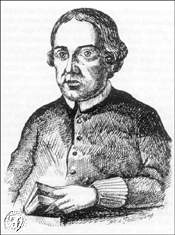Andreas Faulhaber
Chaplain Andreas Faulhaber (born May 21, 1713 in Glatz , County Glatz ; † December 30, 1757 ibid) was a Roman Catholic clergyman . He was executed on the orders of the Prussian King Friedrich II to keep the confessional secret .
Life
Andreas Faulhaber was born the son of the farrier and clockmaker Andreas Faulhaber. At a young age he helped his father in his workshop, but wanted to study theology like his older brother Augustin . Therefore he attended the high school of the Glatzer Jesuit College . Since his father could not finance a second degree in theology, Andreas Faulhaber initially worked as a private tutor for fourteen years. After receiving a table title , he quickly completed his theological studies in Prague . In September 1750 he was ordained a priest for the Archdiocese of Prague , to which the County of Glatz belonged. Its primacyhe celebrated in the Glatzer parish church on Michaelmas Day (29 September) 1750. After chaplain positions in Bad Landeck , Bad Reinerz and Königshain he finally came to the Glatzer parish church, whose pastor was the respective rector of the Jesuit college until 1776.
In the First Silesian War , Glatz, which until then belonged directly to Bohemia , was conquered by the Prussians . Difficult times began for the Catholic clergy under the Prussian governor . The military authorities placed the the clergy, desertion to promote the Prussian soldiers. Andreas Faulhaber took over the pastoral care of the Catholic soldiers at the Kłodzko Fortress, where he also made their confession . A deserter who was caught testified that he had asked the chaplain in confession whether he was allowed to desert, to which the latter is said to have replied: "It would be a difficult matter, but it would not have much to do with it." Faulhaber was born in September 1757 arrested. The deserter withdrew his first testimony several times during subsequent interrogations. Despite proven innocence, Kaplan Faulhaber was hanged on December 30, 1757 on the orders of King Friedrich II . In front of the gallows he was asked to say what the deserter had confessed or to choose the gallows; Faulhaber is said to have put his finger on his mouth and approached the gallows. For the residents of the County of Glatz, Andreas Faulhaber was a martyr of the confessional secret .
The Prussians publicly hung the priest's body on the gallows for two years and seven months. When the Austrians temporarily recaptured the city in the summer of 1760, they took the dead man from the gallows and buried him in the crypt of the parish church of Glatz. The body is said to have been in surprisingly good condition when it was accepted.
On August 20, 1929, the then Glatzer town pastor Franz Monse had the crypt opened and a search for Faulhaber's relics. From his mortal remains, the head with well-preserved teeth, the bones and a white chasuble with a maniple were found . In 1930 preparations were made for his beatification . The files collected for this purpose came to the Glatz parish archive. Since valuable works of art were supposed to be stored in the crypt during the Second World War, Faulhaber's body was relocated on August 17, 1942. In a protocol produced at the same time, it was recorded that when shining into the skull with a flashlight - after almost 200 years - a 4 cm long piece of tongue was still present on the palate.
Due to the Second World War and the subsequent expulsion of the Germans, the beatification process was no longer continued.
literature
- Karl Adolf Menzel : Modern history of the Germans since the Reformation , Volume V, Breslau, 1855; Complete text on the Andreas Faulhaber case
- Polikarp Niestroj: A martyr of the confessional. Life and death of Father Andreas Faulhaber , Glatz 1931
- Anna Bernard : Andreas Faulhaber's death. A tragedy from Glatz's past , Mittelwalde 1922
- Father Henseler SSCC: Father Faulhaber the Glatzer chaplain, a victim of loyalty and duty , Leimen-Heidelberg 1956
- Georg Siegmund: From the confessional to the gallows. Chaplain Andreas Faulhaber from Glatz. A martyr of the confessional , Stein am Rhein 1987
- Chronicle of the parish church in Glatz 1906 to 1946 , started by Pastor Skalitzky, continued by Pastor Dr. Monse (amateur film adaptation by Dr. Dieter Pohl in autumn 1988 in the Glatz parish archive, 2 volumes)
- Joachim-Paul Berke: Journey home to the Silesian County Glatz , 2008, ISBN 3940016993 ( excerpt from the history of Andreas Faulhaber )
- Norbert Bartonitschek: Andreas Faulhaber. In: Biographisch-Bibliographisches Kirchenlexikon (BBKL). Volume 22, Bautz, Nordhausen 2003, ISBN 3-88309-133-2 , Sp. 315-316.
- Michael Hirschfeld: A judicial murder in the Seven Years War. The violent death of the Glatzer priest Andreas Faulhaber (1713–1757) in the context of the conquest and church policy of Frederick II of Prussia . In: Archive for Silesian Church History , vol. 72 (2014), pp. 141–158.
Web links
- Georg Jäschke: Chaplain Andreas Faulhaber. In: Website of the Glatzer Visitatur. Archived from the original on October 10, 2007 .
- Georg Siegmund: On the 250th anniversary of the death of Kaplan Andreas Faulhaber. In: County Glatz. January 24, 2016 .
- Rudolf Grulich : Chaplain Andreas Faulhaber - a martyr of the confessional secret under the Prussian King Friedrich II. (Pdf; 83 kB) Church in Need , October 24, 2017 .
Individual evidence
- ↑ Chronicle of the parish church in Glatz, p. 532
| personal data | |
|---|---|
| SURNAME | Faulhaber, Andreas |
| BRIEF DESCRIPTION | Chaplain and martyr of the former County of Glatz |
| DATE OF BIRTH | May 21, 1713 |
| PLACE OF BIRTH | Glatz , County Glatz |
| DATE OF DEATH | December 30, 1757 |
| Place of death | Bald |

